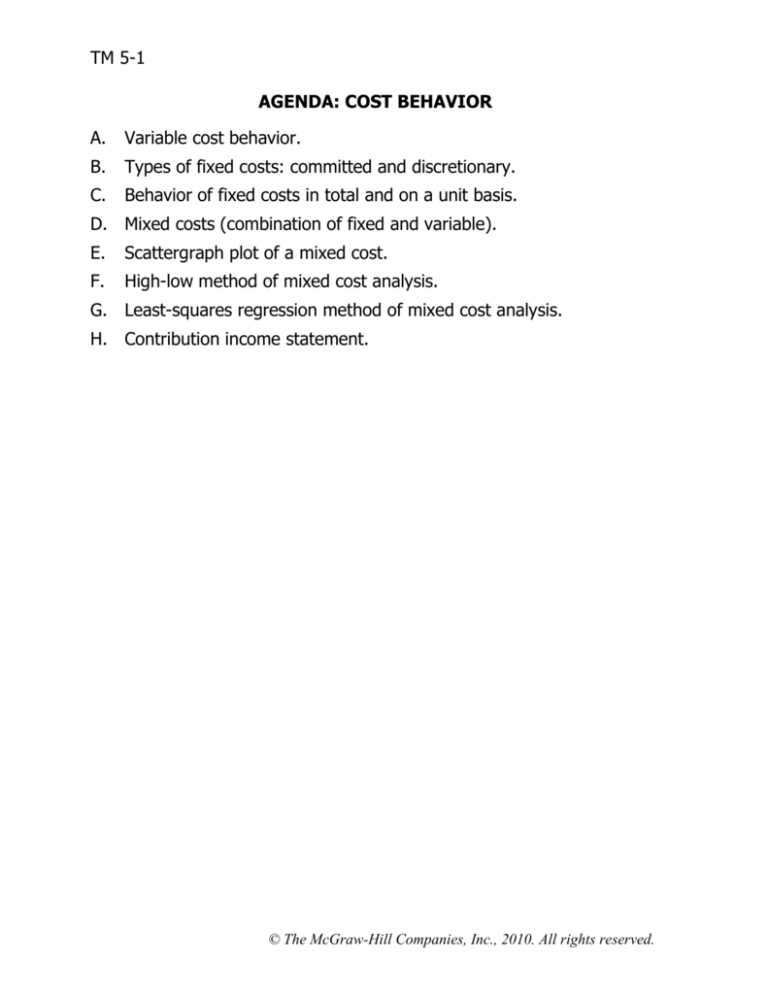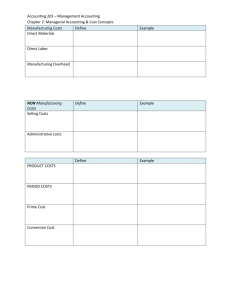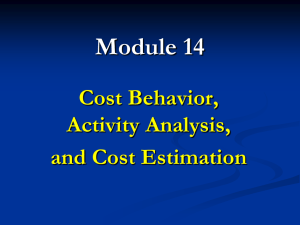
TM 5-1
AGENDA: COST BEHAVIOR
A.
Variable cost behavior.
B.
Types of fixed costs: committed and discretionary.
C.
Behavior of fixed costs in total and on a unit basis.
D. Mixed costs (combination of fixed and variable).
E.
Scattergraph plot of a mixed cost.
F.
High-low method of mixed cost analysis.
G. Least-squares regression method of mixed cost analysis.
H. Contribution income statement.
© The McGraw-Hill Companies, Inc., 2010. All rights reserved.
TM 5-2
VARIABLE COST BEHAVIOR
Many costs can be described as variable, fixed, or mixed.
A variable cost changes in total in proportion to changes in activity; a
variable cost is constant on a per-unit basis.
EXAMPLE: Each bicycle requires one bicycle chain costing $8.
© The McGraw-Hill Companies, Inc., 2010. All rights reserved.
TM 5-3
EXAMPLES OF COSTS THAT ARE NORMALLY VARIABLE WITH
RESPECT TO OUTPUT VOLUME
Merchandising company
Costs of goods (merchandise) sold
Manufacturing company
Direct materials
Direct labor*
Variable elements of manufacturing overhead:
Indirect materials
Lubricants
Supplies
Power
Both merchandising and manufacturing companies
Variable elements of selling and administrative costs:
Commissions
Shipping costs
Service organizations
Supplies
*Whether direct labor is fixed or variable will depend on the labor laws of
the country, custom, and the company’s employment contracts and
policies.
© The McGraw-Hill Companies, Inc., 2010. All rights reserved.
TM 5-4
FIXED COST BEHAVIOR
A fixed cost remains constant in total amount throughout wide ranges of
activity.
EXAMPLE: Fashion photographer Lori Yang rents studio spaces in a
prestige location for $50,000 a year. She measures her company’s activity
in terms of the number of photo sessions.
© The McGraw-Hill Companies, Inc., 2010. All rights reserved.
TM 5-5
FIXED COST BEHAVIOR (continued)
A fixed cost varies inversely with activity if expressed on a per unit
basis.
© The McGraw-Hill Companies, Inc., 2010. All rights reserved.
TM 5-6
TYPES OF FIXED COSTS
• Committed fixed costs relate to investment in plant, equipment, and
basic administrative structure. It is difficult to reduce these fixed costs in
the short-term. Examples include:
• Equipment depreciation.
• Real estate taxes.
• Salaries of key operating personnel.
• Discretionary fixed costs arise from annual decisions by management to
spend in certain areas. These costs can often be reduced in the shortterm. Examples include:
• Advertising.
• Research.
• Public relations.
• Management development programs.
TREND TOWARD FIXED COSTS
The trend is toward greater fixed costs relative to variable costs. The
reasons for this trend are:
• Increased automation of business processes.
• Shift from laborers paid by the hour to salaried knowledge workers.
© The McGraw-Hill Companies, Inc., 2010. All rights reserved.
TM 5-7
MIXED COSTS
A mixed (or semi-variable) cost contains elements of both variable and
fixed costs.
Example: Lori Yang leases an automated photo developer for $2,500 per
year plus 2¢ per photo developed.
Equation of a straight line: Y = a + bX
Y = $2,500 + $0.02X
© The McGraw-Hill Companies, Inc., 2010. All rights reserved.
TM 5-8
SCATTERGRAPH METHOD
As the first step in the analysis of a mixed cost, cost and activity should
be plotted on a scattergraph. This helps to quickly diagnose the nature of
the relation between cost and activity.
Example: Piedmont Wholesale Florists has maintained records of the
number of orders and billing costs in each quarter over the past several
years.
Quarter
Year 1—1st
2nd
3rd
4th
Year 2—1st
2nd
3rd
4th
Year 3—1st
2nd
3rd
Number
of Orders
1,500
1,900
1,000
1,300
2,800
1,700
2,100
1,100
2,000
2,400
2,300
Billing
Costs
$42,000
$46,000
$37,000
$43,000
$54,000
$47,000
$51,000
$42,000
$48,000
$53,000
$49,000
These data are plotted on the next page, with the activity (number of
orders) on the horizontal X axis and the cost (billing costs) on the vertical Y
axis.
© The McGraw-Hill Companies, Inc., 2010. All rights reserved.
TM 5-9
A COMPLETED SCATTERGRAPH
Y
$60,000
Regression Line
Billing Costs
$50,000
$48,000
$40,000
$30,000
$20,000
$10,000
X
$0
0
500
1,000
1,500
2,000
2,500
3,000
Number of Orders
The relation between the number of orders and the billing cost is
approximately linear. (A straight line that seems to reflect this basic
relation was drawn with a ruler on the scattergraph.)
Because a straight line seems to be a reasonable fit to the data, we can
proceed to estimate the variable and fixed elements of the cost using one
of the following methods.
1.
Quick-and-dirty method based on the line in the scattergraph.
2.
High-low method.
3.
Least-squares regression method.
© The McGraw-Hill Companies, Inc., 2010. All rights reserved.
TM 5-10
THE QUICK-AND-DIRTY METHOD
The straight line drawn on the scattergraph can be used to make a quickand-dirty estimate of the fixed and variable elements of billing costs.
Recall that we are trying to estimate the fixed cost, a, and the variable cost
per unit, b, in the linear equation Y= a + bX.
• The vertical intercept, approximately $30,000 in this case, is a rough
estimate of the fixed cost.
• The slope of the straight line is an estimate of the variable cost per
unit.
Select a point falling on the line (in this case 2,000 orders):
Total billing cost for 2,000 orders ........
Less fixed cost element (intercept) ......
Variable cost element for 2,000 orders
$48,000
30,000
$18,000
Variable cost per unit = $18,000 ÷ 2,000 orders = $9 per order.
Therefore, the cost formula for billing costs is $30,000 per quarter plus $9
per order or:
Y = $30,000 + $9X,
where X is the number of orders.
This method of estimating fixed and variable costs is seldom used in
practice because of its imprecision.
Nevertheless, it is always a good idea to plot the data on a scattergraph
before using the more precise high-low or least-squares regression
methods.
© The McGraw-Hill Companies, Inc., 2010. All rights reserved.
TM 5-11
ANALYSIS OF MIXED COSTS: HIGH-LOW METHOD
EXAMPLE: Kohlson Company has incurred the following shipping costs over
the past eight months:
January ....
February...
March.......
April .........
May..........
June .........
July ..........
August .....
Units
Sold
6,000
5,000
7,000
9,000
8,000
10,000
12,000
11,000
Shipping
Cost
$66,000
$65,000
$70,000
$80,000
$76,000
$85,000
$100,000
$87,000
With the high-low method, only the periods in which the lowest activity and
the highest activity occurred are used to estimate the variable and fixed
components of the mixed cost.
High activity level, July .......
Low activity level, February
Change .............................
Variable cost=
Units
Sold
12,000
5,000
7,000
Shipping
Cost
$100,000
65,000
$ 35,000
Change in cost
$35,000
=
=$5 per unit
Change in activity 7,000 units
Fixed cost = Total cost - Variable cost element
= $100,000 - (12,000 units × $5 per unit)
= $40,000
The cost formula for shipping cost is:
Y = $40,000 + $5X
© The McGraw-Hill Companies, Inc., 2010. All rights reserved.
TM 5-12
EVALUATION OF THE HIGH-LOW METHOD
Y
high
level of
activity
Shipping Costs
$100,000
$80,000
low level
of
activity
Variable
Cost
$5/unit
$60,000
$40,000
Fixed
Cost
$40,000
$20,000
X
$0
0
2,000
4,000
6,000
8,000 10,000 12,000
Units Sold
The high-low method suffers from two major defects:
1. It throws away all but two data points.
2. The periods with the highest and lowest volumes are often
unusual.
© The McGraw-Hill Companies, Inc., 2010. All rights reserved.
TM 5-13
LEAST-SQUARES REGRESSION METHOD
The least-squares regression method for analyzing mixed costs uses
mathematical formulas to determine the regression line that minimizes the
sum of the squared “errors.”
© The McGraw-Hill Companies, Inc., 2010. All rights reserved.
TM 5-14
LEAST-SQUARES REGRESSION (continued)
Example: Montrose Hospital operates a cafeteria for employees.
Management would like to know how cafeteria costs are affected by the
number of meals served.
Meals
Served
X
April ............
May ............
June ...........
July.............
August ........
September ..
4,000
1,000
3,000
5,000
10,000
7,000
Total
Cost
Y
$9,500
$4,000
$8,000
$10,000
$19,500
$14,000
Statistical software or a spreadsheet program can do the computations
required by the least-squares method. The results in this case are:
Intercept (fixed cost) ......... $2,433
Slope (variable cost) .......... $1.68
R2 ..................................... 0.99
The fixed cost is therefore $2,433 per month and the variable cost is $1.68
per meal served, or:
Y = $2,433 + $1.68X,
where X is meals served.
R2 is a measure of the goodness of fit of the regression line. In this case, it
indicates that 99% of the variation in cafeteria costs is due to the number
of meals served. This suggests an excellent fit.
© The McGraw-Hill Companies, Inc., 2010. All rights reserved.
TM 5-15
TRADITIONAL VERSUS CONTRIBUTION INCOME STATEMENT
Traditional Approach
(costs organized by function)
Sales ..............................
Cost of goods sold* ........
Gross margin ..................
Selling and administrative expenses:
Selling* .......................
$15,000
Administrative* ............
6,000
Net operating income ......
Contribution Approach
(costs organized by behavior)
$60,000
34,000
26,000
21,000
$ 5,000
Sales .............................
Variable expenses:
Variable production ..... $12,000
Variable selling ............
3,000
Variable administrative
1,000
Contribution margin .......
Fixed expenses:
Fixed production .........
22,000
Fixed selling ................
12,000
Fixed administrative.....
5,000
Net operating income .....
$60,000
16,000
44,000
39,000
$ 5,000
* Contains both variable and fixed elements because this is the income statement for a manufacturing
company. If this were a merchandising company, then the cost of goods sold would be entirely
variable.
© The McGraw-Hill Companies, Inc., 2010. All rights reserved.









